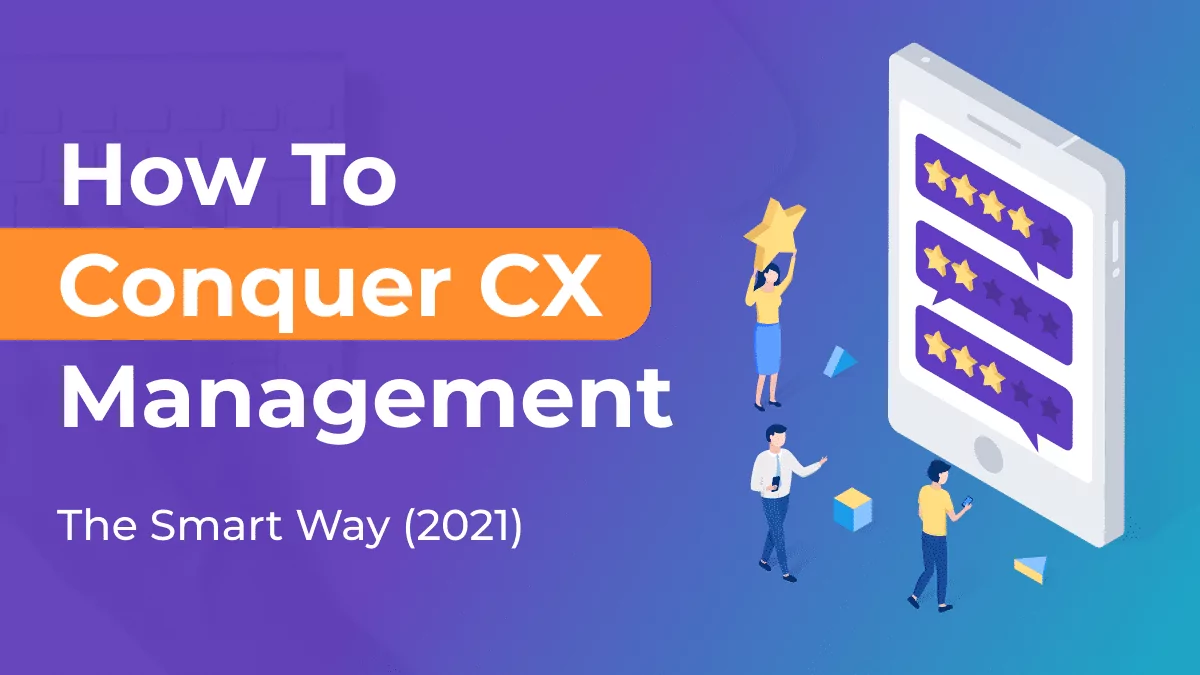
In the age of digitalization, the best opportunity for businesses lies in how they can delight customers both online and offline.
Customer experience management seeks to provide a holistic brand experience across all customer channels. It goes beyond traditional measures of customer satisfaction.
As per the Grand View Research report, the global customer experience management market is worth $7.6 billion in 2020.
Over the coming years, the market is set to continue growing and sustain an impressive growth rate. The same report also shows that the compound annual growth rate is expected at 17.7 percent from 2020 through to 2027.
Hence, customer experience is something that brands should not ignore because customer loyalty and retention is directly related to experience.
This article explains customer experience management (CXM) and details the purpose, strategy, methodology, and importance of CXM. It also explains how to set-up CXM operations in depth.
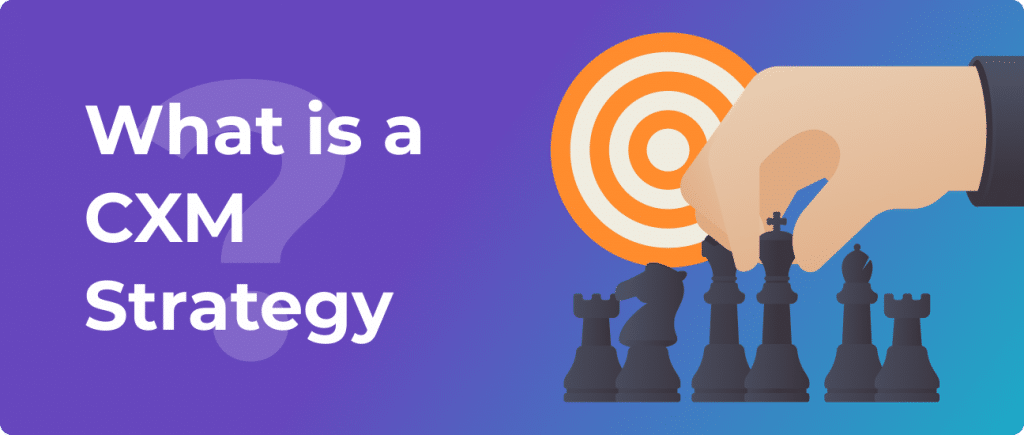
What Does Customer Experience Management Mean?
Gartner defines CXM as the practice of reacting to customer interactions to meet or exceed customer expectations, increasing customer satisfaction, loyalty, and advocacy.
Hence, CXM is the effective management of customer interactions at each stage of the buyer journey to retain customers and increase revenue.
What is the Purpose of Customer Experience Management?
The primary purpose of CXM is to improve the overall experience of a customer with a brand.
More than 75% of customer management executives consider customer experience highly important to the business.
The Consumer Intelligence report by PwC shows that 73% of consumers consider customer experience as an important factor in their purchasing decision.
Therefore, to achieve excellent customer experience, potential objectives include a focus on the following:
- To retain your existing customers
- To attract new customers
- To receive a higher greater share of the wallet from existing customers
What is a Customer Experience Management Strategy?
A CXM strategy guides you to take actions that deliver a remarkable customer experience across all customer touchpoints.
CXM requires brands to have a 360-degree view of customers, with integrated, up-to-date data on customer accounts.
A successful CXM strategy considers several factors, including competitive insight, consumer research, marketplace data, and mission.
According to Salesforce, 52% of marketers adapt their marketing strategy and tactics based on customer interactions and feedback.
These are the key steps involved in an effective customer experience management strategy:
1- Understand Your Customer
The first step is to understand your customers’ needs, motivations, and behaviors.
Two ways to understand your customers better are:
- Profile the types of customers to know how to market to them. Create a document that lists the interests, buying patterns, demographic characteristics, and pain points of your customers. Here is an example of a describes the real customer:
- Create buyer personas. It helps you implement customer segmentation based on factors such as age, interests, and spending habits. Buyer personas help you in product development to suit the needs of your target customers. Thus, it helps attract high-value visitors, leads, and customers to your business. Here is an example:
2- Create a Customer Journey Map
The customer journey mapping research report shows that nearly 67% of the participants use a customer journey map. As per the same study, around 90% of the surveyed customer journey mapping practitioners said that their program is delivering a positive impact.
Create a customer journey map. It helps you to identify customer touchpoints and anticipate how customers will interact with your product or service.
It outlines customer needs, pain points, opportunities and gives you a view of the end-to-end customer experience. Below is an example of a customer journey map.
3- Develop an Emotional Connection
As per a report by Deloitte, Trustworthiness (83%), integrity (79%), and honesty (77%) are the emotional factors that consumers feel most align with their favorite brands.
Create a brand personality that evokes emotions and connections for a customer. It helps establish a relationship between the customer and the company.
Use consumer insight tools like Revuze to understand customer emotions. Here are the top features offered by Revuze:
- Automates the process of sentiment analysis to maximize its accuracy and success rate.
- Offers sentiment analysis not just by brand but also by-products and features.
- Automates product review analysis by understanding the voice of the customer using qualitative eCommerce opinion insights.
4- Capture Customer Feedback
Research by Bain & Company shows that 80% of companies believe they are providing great customer service, but only 8% of customers agree with them.
Measure customer satisfaction in real-time by using post-interaction and real-time feedback surveys. Tools such as Revuze are highly useful. It collects and turns unstructured data into market insights so that anyone can make decisions based on consumer opinion data. It allows you to scan millions of opinions in real-time and get the deep insights you need to respond to issues as they arise.
Customer feedback helps you to track customer perceptions. It enables quality monitoring and measures the success of the customer experience strategy.
How to Improve Customer Experience Management?
As per the McKinsey report, maximizing satisfaction with customer journeys has the potential to increase customer satisfaction by 20% while lowering the cost of serving customers by 20%.
Here are the best ways to improve customer experience management:
1- Leverage The Power of Data
Measure customer experience and collect data on their satisfaction levels across key points of interaction with the company.
Customer satisfaction metrics are the numerical scores that indicate the health of your brand’s offerings and relationships with the customer.
The top three surveys and their scoring are:
- Customer Satisfaction Score (CSAT): It measures the satisfaction level of a customer with the product and service of a company. The higher the CSAT score means the better CXM. A CSAT score of 80% or more is a good indicator of success
- Net Promoter Score (NPS): It measures the loyalty of customers towards a brand. A high NPS means your CXM strategy is perfect. NPS scores between 0-6 are considered as detractors or potential detractors, 7-8 are passive, and 9-10 are promoters.
- Customer Effort Score (CES): It measures the ease with which customers execute a task using your product/service. Customers taking the survey choose between multiple answers ranging from “Very Difficult” to “Very Easy.”
2- Make Personalization A Priority
Personalizing means designing your services and products to meet customer’s individual requirements.
Nearly 56% of customer experience professionals aim to improve and personalize the customer experience.
A customer personalization strategy allows you to identify customers with specific needs, helping you to create a unique and targeted experience for them.
Here are the key ways to personalize your content:
- Collect Data: Analyze all your customer-related data to acquire valuable feedback to enable you to design a working strategy.
- Segment Your Audience: 39% of businesses see an increase in their open rates who use email-segmentation. You can segment your audience based on location, age, gender, or online shopping habits. Use behavioral tracking to target your email customers to help boost your email’s relevance.
- Execute Your Strategy Across Multi-Channel: Businesses need to evolve towards cross-channel strategies. 75% of consumers expect brands to offer continuous experience when moving between channels, so they do not have to start over each time.

3- Make the Best Use of Your CRM System
Investing in both CRM and CXM helps your business to deliver a positive and meaningful experience.
CRM and CXM have their own operational strengths that enable you to capture and manage valuable data.
A CRM system captures a wide range of information about your customers and how they interact with your business. It informs you about how best to implement future campaigns and business strategies.
74% of businesses using CRM claimed that their customer relationships are stronger through good customer experiences.
Whereas CXM helps you identify how your customers think and feel when engaging with your brand.
Here is how you can integrate and use CXM and CRM together:
- Use CRM to collect customer data, such as their spendings, gender, or age. Take this data and align it with the experiential data such as NPS or CSAT. This gives you an opportunity to follow trends on experience, rather than just data about customer actions.
- Bring CRM data into your CXM to predict how customer experience changes on transactional KPIs.
- Build customer relationships by incorporating CXM data into your CRM. Pull out customer history using CRM. Then, add CXM data to see whether the customer is facing any issues. It helps you to identify customers at risk of churning.
4- Take Control of Social Media
As per Statista, 48% of consumers expect a response to social media questions and complaints within 24 hours.
Also, 71% of consumers with a good social media service experience with a brand are more likely to recommend it to others.
There are several avenues within social media platforms. From visual platforms, such as Instagram and YouTube to network-based platforms like LinkedIn and Facebook.
Here are the best ways to boost your customer experience management on social media:
- Consistently post new content to your social feeds to build your brand awareness.
- Have conversations with your followers.
- Use relevant and trending hashtags.
- Post unique content.
- Respond to comments, questions, and brand mentions.
You can use tools such as Sprout’s Group Report, Sparkcentral, or Hootsuite to supplement your social media insights.
5- Leverage Artificial Intelligence
As per Gartner, the use of AI grew by 270% over the past four years.
As per Forbes, 95% of all customer interactions will be supported by artificial intelligence by 2025.
Here are how AI customer support can be used to better serve your customers and enhance growth:
- Chatbots: AI-based chatbots are helpful to personalize customer interactions and to accelerate resolution.
- Face Recognition: With the help of AI, you can enable customers to even place orders or access devices with fingerprints or face recognition.
- Predictive Analysis: AI predicts future events based on historical data to enable marketers to take proactive steps and make intelligent decisions to improve customer experience.
Why Should Brands Use A Customer Experience Management System?
Research by Gartner shows that 89% of companies compete primarily based on their customer’s experience.
Here are the advantages of using a customer experience management system:
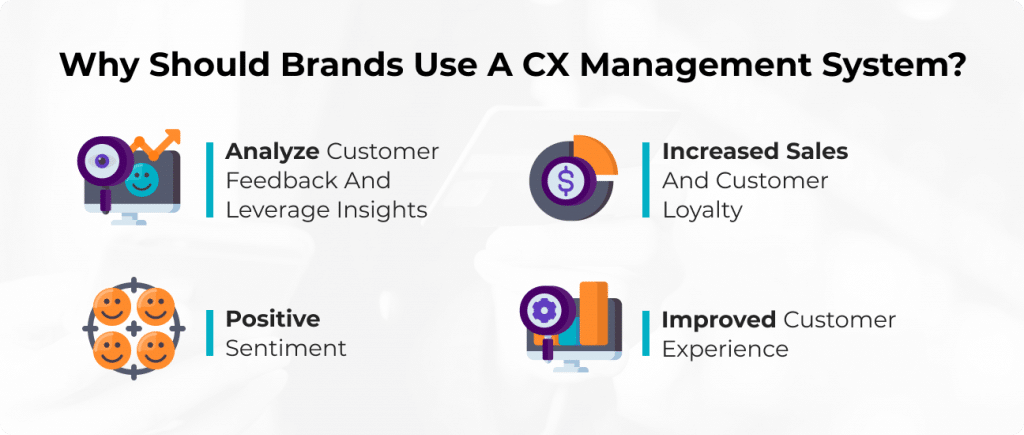
1- Analyze Customer Feedback and Leverage Insights
CXM allows you to get feedback from customers. Analyzing and using this feedback, you can improve or fill up crucial gaps in customer experience processes.
A CXM system leverages insights to enable you to act swiftly on customer issues and concerns, thereby further reinforcing customer satisfaction and loyalty.
2- Improved Customer Experience
A report by McKinsey & Company shows that a great customer experience increases customer satisfaction by 20%. It increases revenue by 15% and even lowers customer care spending by 20%.
CXM helps businesses to optimize operations and utilize new business digital models to fuel growth through a sustainable differentiation.
3- Positive Sentiment
Approximately 60% of consumers visit a brand’s website after reading positive reviews, and over 70% trust a brand more after seeing such reviews.
Customers who are fully connected with a brand are 52% more valuable than customers who are just satisfied.
CXM provides smooth connectivity between companies and customers for achieving organization goals and customer expectations.
4- Increased Sales and Customer loyalty
According to Forrester Research, companies that work on customer experience management increase their advantage by 14%, in terms of the customers’ initiative to buy more.
92% of consumers are more likely to stay loyal to the brand if a positive emotional connection is created with a brand.
CXM combines customer satisfaction, loyalty, retention, user experience, relationship management, experiential marketing, and customer-centricity to retain their market share in the competitive world.
Customer Experience Management Book We Recommend
Below is the list of the best books on Customer Experience Management (CXM):
- The Effortless Experience by Nick Toman, Matthew Dixon, and Rick DeLisi.
- Hug Your Haters by Jay Baer.
- Winning the Talent Shift by Berta Aldrich.
- Customer Understanding by Annette Franz.
Final Thoughts
Keeping your customers satisfied by understanding their needs and behavior is crucial for your business growth. Therefore, investing in customer experience management is a good decision to create strategies that add value to your business.
Customer experience management software such as Revuze combines behavioral analytics with automated engagement actions to drive customer retention and product success. The right CXM strategy, along with an optimal customer experience platform, reduces costs, increases brand value, and allows you to gain the edge in the market to stand out from your competition.
 All
Articles
All
Articles Email
Analytics
Email
Analytics




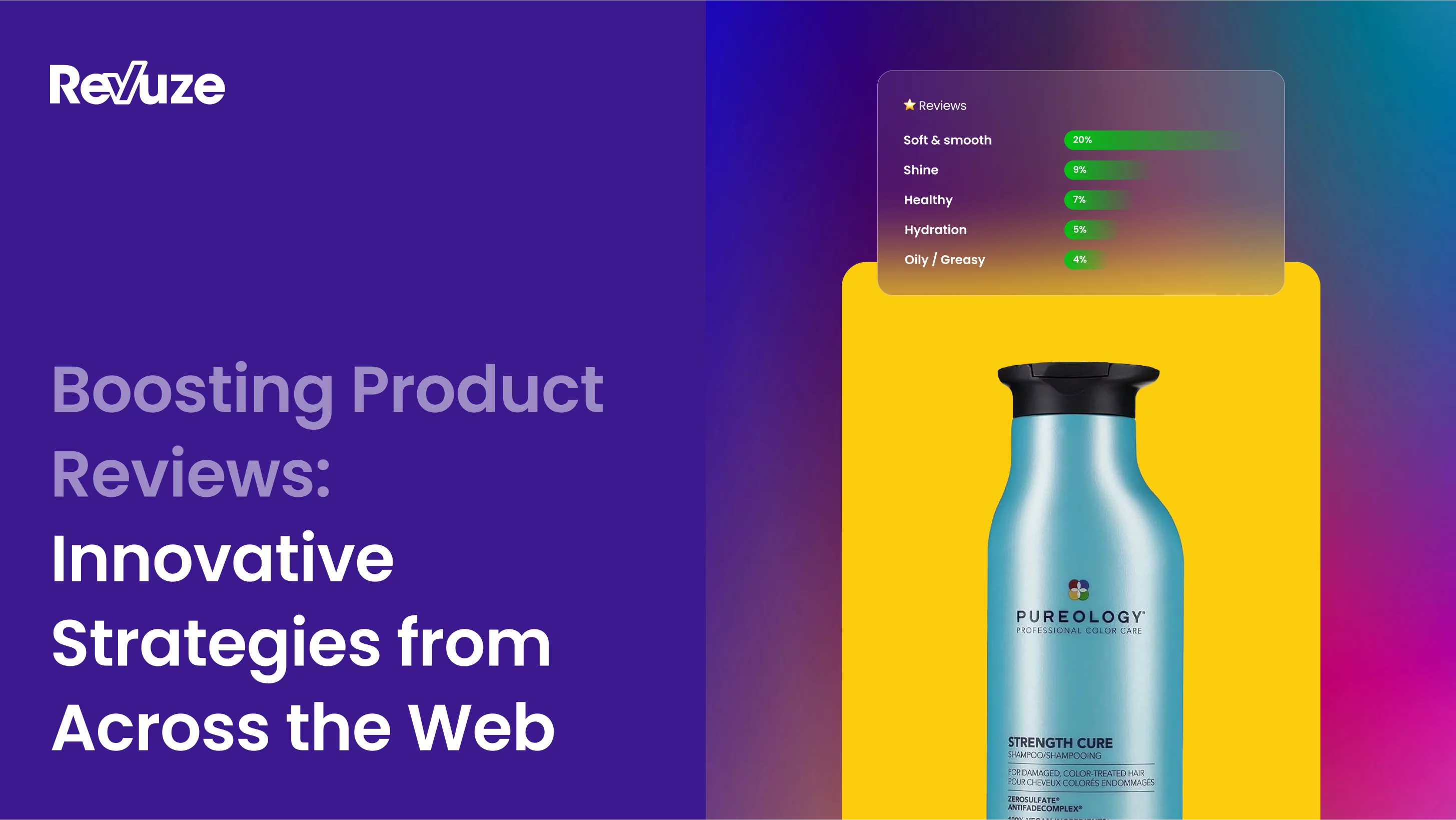

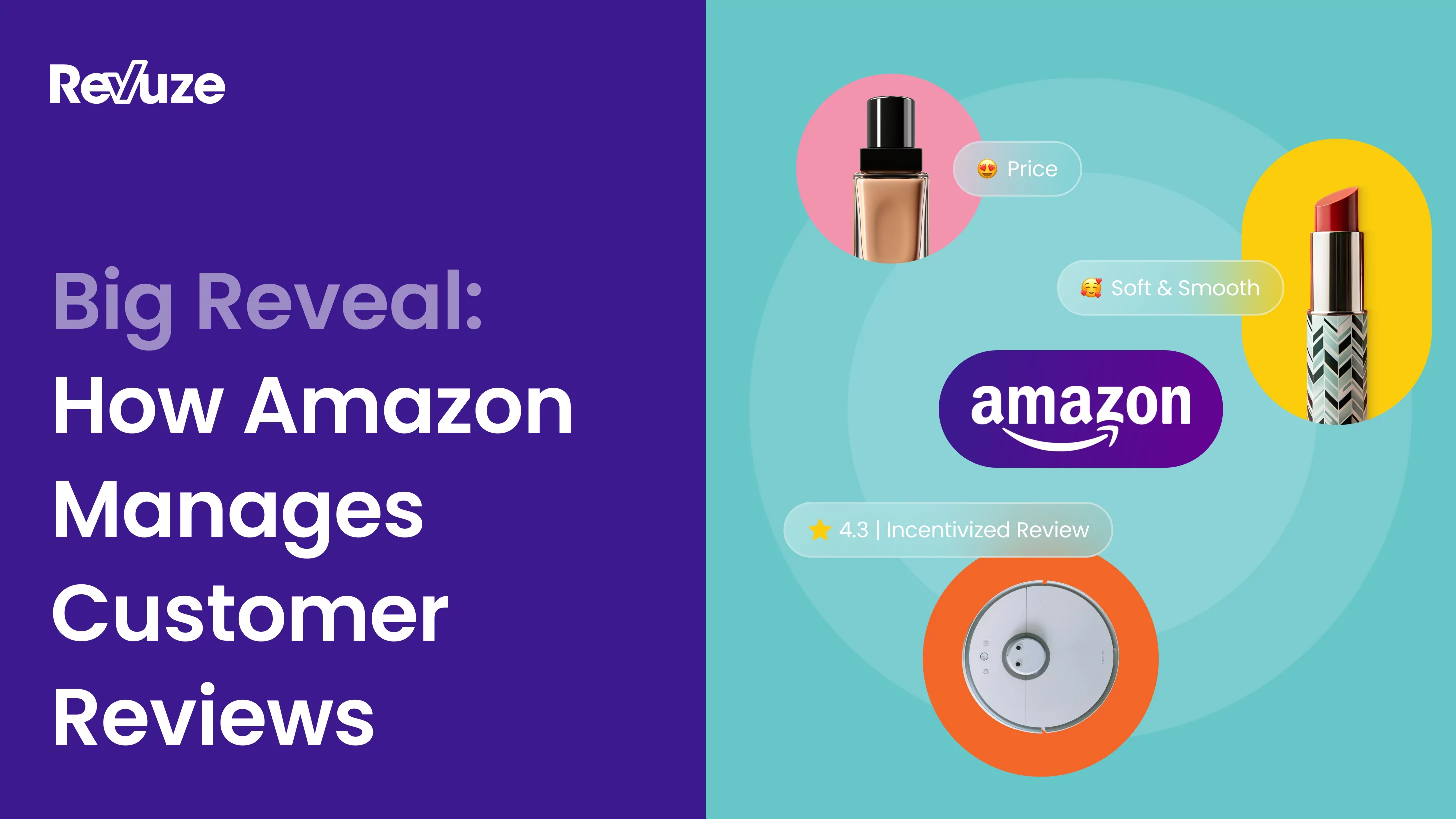

 Agencies
Insights
Agencies
Insights